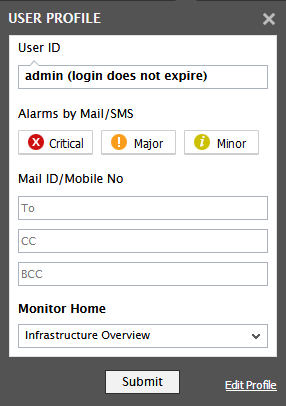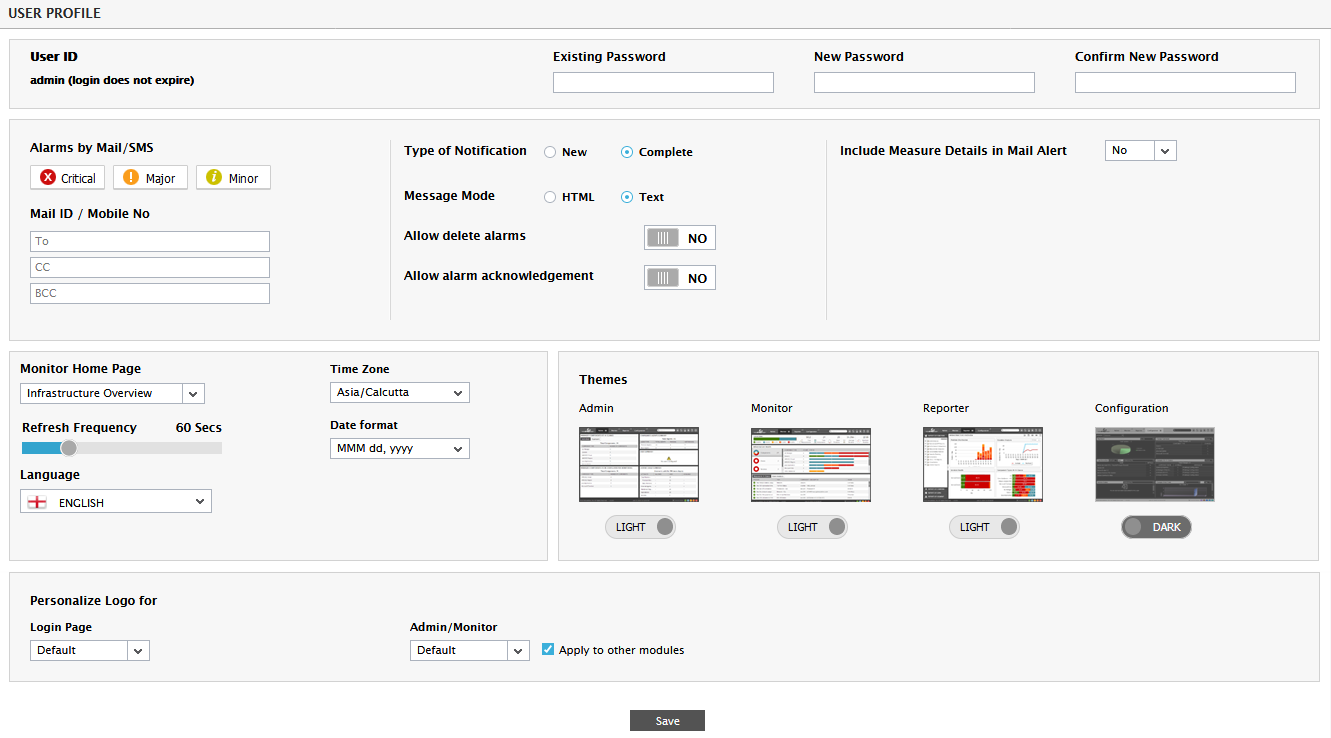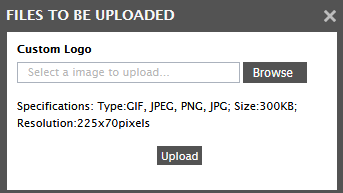The User Profile Window
Whenever a user logs into the eG administrative interface, he/she can view/edit his/her profile by clicking the tool in the toolbar of the eG management console. The USER PROFILE drop-down window then appears (see Figure 1). This window allows the user who is logged into the eG management console to quickly edit his/her profile.

Figure 1 : The User Profile window
By default, Figure 1 shows the current settings of the user. The User ID text box displays the login ID of the user. The Alarms by Mail/SMS section highlights whether the user is entitled to receive a combination of Critical/Major/Minor alerts generated in the monitored environment. If the user has pre-configured to receive the alerts in his/her email ID/Mobile, then the To field displays the email ID/Mobile number of the user. If the user has configured the alternate email IDs to send the alerts then such email IDs will be populated in the CC and BCC fields. The default page that the user needs to view upon navigating to the eG monitoring console is displayed in the Monitor Home list. By default, the Infrastructure Overview is chosen from this list. If the user has not configured any of the above, then he/she can configure the same from this window and click the Submit button. If the user wishes to edit his/her profile, then, he/she can click the Edit Profile link in Figure 1.
Upon clicking the Edit Profile link in Figure 1, Figure 2 appears.

Figure 2 : The USER PROFILE page that is used to edit the user preferences
Using Figure 2, the user is allowed to change his/her password. To provide a new password, the user should specify the Existing Password and then specify a password in the New Password text box. To confirm the password, it is necessary to enter the new password in the Confirm Password text box.
Alarms by Mail / SMS: The eG manager is capable of alerting users as and when problems occur. The alarms are classified into Critical, Major, and Minor. By choosing one or more of the check boxes corresponding to the Alarms by Mail /SMS field, a user can indicate his/her preference in terms of the priority of problems for which he/she wishes critical priority alarms alone and not the other types. If no alarm priority is chosen, then the user will not receive alerts by email / SMS.
Type of Notification: By choosing the New option, an administrator can indicate to eG Enterprise that when alerting a user via email/SMS, the system should send the details of newly added alarms only. On the other hand, if the Complete option is chosen, the user will receive a complete list of current alarms every time a mail/SMS message is generated.
Message Mode: This option governs the format in which an alarm is reported in an email message. If the HTML option is chosen, the alarm details are formatted as HTML text whereas the Text option formats the alarm details as plain text.
Note:
If HTML is chosen as the Message Mode, then alarms sent by mail will carry a hyperlink named HOME at the right top corner. The destination of the hyperlink can be configured using the eg_services.ini file in the <EG_ INSTALL_ DIR>\manager\config directory. The [MISC_ ARGS] section of the eg_services.ini file contains a MailHomeURL parameter that is left blank by default. In this case, clicking on the HOME link will connect you to the eG manager and open the login screen. By providing a specific URL against MailHomeURL, you can ensure that monitor users are lead to the specified URL upon clicking the HOME hyperlink.
Include Measure Details in Mail Alerts: By default, the No option is chosen from the Include Measure Details in Mail Alerts list, indicating that the email alerts to a user will not include any measure details. However, if you want the email alerts to a user to include a time-of-day graph of the problem measure plotted for the last 1 hour (by default), then, pick the Graph option from this list. If you want the email alerts to a user to include the data plotted in a 1-hour measure graph, then, pick the Data option from this list.
Allow delete alarms: To allow the new user to delete alarms from the CURRENT ALARMS window in the eG monitor interface, select the Yes option against the Allow Delete Alarms field.
Allow alarm acknowledgement: Optionally, specific users can be configured to acknowledge an alarm displayed in the eG monitor interface. By acknowledging an alarm, a user can indicate to other users that the issue raised by an alarm is being attended to. In fact, if need be, the user can even propose a course of action using this interface. In such a case, a user with Admin or Supermonitor privileges (roles) can edit the acknowledgement by providing their own comments/suggestions on the proposed action. The acknowledgement thus works in three ways:
- Ensures that multiple members of the administrative staff do not unnecessarily invest their time and effort in resolving a single issue;
- Serves as a healthy forum for discussing and identifying permanent cures for persistent performance ills;
- Indicates to other users the status of an alarm
To enable the alarm acknowledgement capability for the new user, select the Yes option against the Allow alarm acknowledgement field.
Monitor Home Page: By default, the Infrastructure Overview appears as the home page of the eG monitoring console - i.e., as soon as a user logs into the monitoring console, the Infrastructure Overview appears as the first page by default. eG Enterprise however, allows administrators to set any page they deem fit as the Monitor Home Page for individual users to the eG monitoring console. This way, every user, upon logging into the eG monitor interface, is enabled to view straight up the information that interests him/her the most, thereby saving time and minimizing the mouse clicks that may be required to navigate to that information!
The home page preference is typically driven by the monitoring needs of specific users and the roles assigned to them. For instance, a service manager, who is responsible for minimizing/eliminating service outages, would want to know on login how all the critical services in the environment are performing currently, and which services are in an abnormal state. For this purpose, administrators may want to set the Service List as the home page of such users.
Refresh Frequency: Indicates how often the web pages of the eG monitor module need to be refreshed. By default, this is set to 60 seconds.
Date format to be used: The default date format for the eG user interface is MMM dd, yyyy. This date format can be changed depending upon the country in which the user being created lives, by selecting a different format from the Date format list. Whenever this user logs in, the eG user interface will display dates in the chosen format only. This is particularly useful in MSP environments, where customers of the MSP could be separated by geographies and may require performance and problem reports of their hosted enivonments to be delivered in the date format that applies to their geography.
Default language: The eG manager provides multi-language support, but the default language is 'ENGLISH'. To configure the eG manager to support a different language by default, select the language of your choice from the Default language list.
Time Zone: eG Enterprise is often deployed to manage servers in different geographies and time zones. For example, a large enterprise may have a central eG Enterprise management console to which agents from different locations can be reporting. In a managed service provider environment, multiple customer infrastructures can be monitored from the same eG manager. In such situations, users (administrators in different geographies, customers of an MSP in different regions) prefer to see the performance metrics reported in their respective time zones. eG Enterprise allows time zones to be associated to each user’s profile. By default, all users are associated with the local time zone of the location where the eG manager is hosted. However, an administrator can change the time zone preferences of a user to suit that user’s requirements. For this, when creating a user profile, the administrator can pick a Time zone for that user. When that user logs into the eG Enterprise console, all the metrics, alerts, and reports that the user accesses will be displayed in the respective local time zone. This new capability ensures that eG Enterprise users receive a completely ‘local’ experience, regardless of which part of the world the eG manager is located in.
Themes: eG Enterprise has a refreshing new user interface. Designed based on Web 2.0 concepts, the eG Enterprise interface is visually appealing, easier to navigate, intuitive, and fluid. The interface is designed to be pleasing on the eye, to be easier to navigate, so that users can get to the tasks they need to perform faster, and to function well over local and wide area networks and on any device (including tablets and big screens). A clear separation between the visual representation and the data that is rendered ensures that only changes in data values are sent over the network, leading to bandwidth optimization. Users can now choose between a light and dark color theme based on their tastes for all the modules offered by the eG Enterprise. If the user wishes to choose a dark theme for the monitor module, then he/she may click the Light button below the Monitor option.
Personalize Logo for: Each user of the eG Enterprise system is allowed to configure a custom logo that is displayed in the eG user interface on all the modules. This way, different users can see different logos in the eG user interface. Accordingly, the user can set a different logo for the login screen and set another logo for the different modules offered by the eG Enterprise system. By default, the Default option is chosen from the Login Page. If you choose Custom option from this list, then an Upload button appears.

Figure 3 : Uploading a custom logo
Clicking the Upload button opens Figure 3 where you would be allowed to upload the image of your choice. In the Custom Logo text box, Specify the full path to the image file to be uploaded using the Browse button therein and click the Upload button.
Similarly, you can upload a custom logo for the Admin/Monitor consoles of the eG Enterprise system.
